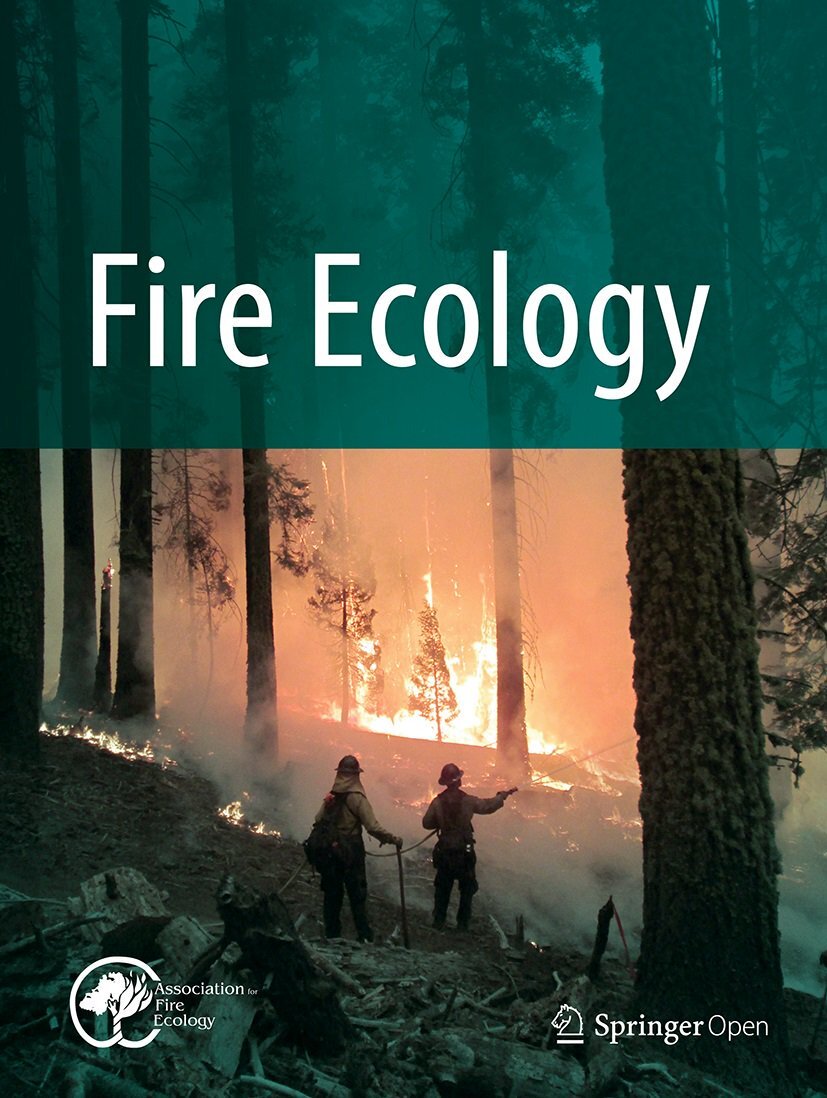Novel Fire Regimes Issue in Philosophical Transactions of the Royal Society B
In April 2025, a theme issue on novel fire regimes was published in Philosophical Transactions of the Royal Society B (Volume 380, Issue 1924). Part I covers fire regime descriptions, Part II is about drivers of fire regime variation, Part III considers ecological impacts of fire regimes, and Part IV discusses perspectives on fire regimes. The research articles in this issue span several countries around the world.
From Royal Society Publishing: “This theme issue adds to growing body of research into novel fire regime variation, and the joint effects of climate, vegetation and human activity. Winter warming and high-pressure anomalies amplify fire risks; and land use changes exacerbate fire management challenges. These forces disrupt ecosystems and plant-fire feedbacks, triggering vegetation shifts with uncertain effects on biodiversity. While boreal fires demonstrate top-down climate controls, fires at mid-latitudes are driven by spatially heterogeneous factors. Effective solutions prioritize Indigenous-led burning and community governance over restrictive policies, coupled with adaptive strategies for novel fire behaviour. Innovative monitoring tools are critical for improving fire impact assessments. This theme issue highlights the unprecedented importance of transdisciplinary research and adaptive management to address escalating fire risks in a changing climate.”
See below for a list of articles and authors, and be sure to click the button at the bottom of the page to read the full issue!
Introduction
Novel wildfire regimes under climate change and human activity: patterns, driving mechanisms, and ecological impacts
By Zehao Shen, Kate Giljohann, Zhihua Liu, Juli Pausas, and Brendan Rogers
Part I: Fire Regime descriptions
The fire regimes of the Cerrado and their changes through time
By Carlota Segura-Garcia, Ane Alencar, Vera L. S. Arruda, David Bauman, Wallace Silva, Dhemerson E. Conciani, and Imma Oliveras Menor
Quantifying wildfire risk to the built environment in rural rangelands of the US Interior West
By Devan McGranahan and Carissa Wonkka
Stable isotope analysis in tree rings of conifer species relevant to fire history study
By Mao Wei, Mengxia Liu, Yuanfan Ma, Mulualem Tigabu, Keyan Fang, Xinbin Guo, Wenxia Zheng, and Futao Guo
Part II: Drivers of Fire REgime Variation
Are fire regimes the result of top-down or bottom-up drivers?
By Juli G. Pausas, Jon E. Keeley, and Alexandra D. Syphard
Local and regional factors influencing historical forest fires in eastern Fennoscandia
By Gargi Tariyal, Roman Flury, Jari Kouki, and Tuomas Aakala
Collapse and recovery of livestock systems shape fire regimes on the Eurasian steppe: a review of ecosystem and biodiversity implications
By Johannes Kamp, Tejas Bhagwat, Norbert Hölzel, and Ilya Smelansky
persistent positive anomalies in geopotential heights drive enhanced wildfire activity across Europe
By Kerryn Little, Dante Castellanos-Acuna, Piyush Jain, Laura Graham, Nicholas Kettridge, and Mike Flannigan
When is fire weather extreme enough for active fire spread in Canada?
By Xianli Wang, Tom Swystun, Jacqueline Oliver, Kathryn Levesque, and Mike D. Flannigan
Climate, Vegetation, People: disentangling the controls of fire at different timescales
By Sandy P. Harrison, Olivia Haas, Patrick J. Bartlein, Luke Sweeney, and Guoxi Zhang
Part III: Ecological Impacts of Fire REgimes
The influence of changing fire regimes on specialized plant-animal interactions
By Felicity E. Charles, April E. Reside, and Annabel L. Smith
The effects of fire frequency on leaf and bark flammability strategies in subtropical semi-humid evergreen broadleaved forests in China
By Caifang Luo, Zehao Shen, Xinpei Wang, Mingjian Xiahou, Yuyang Xie, Tao Yang, and Juli Pausas
Fire-driven alternative vegetation states across the temperate ANdes
By Diego P. Ramírez, Sergio A. Estay, Alejandro Miranda, Juli G. Pausas, and Susana Paula
Post-Fire spectral recovery and driving factors across the boreal and temperate forests
By Kaili Li, Zhihua Liu, Wenru Xu, Wenjuan Wang, Jiajia Su, Qiushuang Lv, Wenhua Guo, and Marie Johnson
A global expert elicitation on present-day human-fire interactions
By Cathy Smith, Ol Perkins, Jayalaxshmi Mistry, Bibiana A. Bilbao, Rebecca Bliege Bird, Amy Cardinal Christianson, Kayla Maria de Freitas, Wolfram Dressler, Erle C. Ellis, Ludivine Eloy, Cynthia Fowler, Simon Haberle, Jed O. Kaplan, Paul Laris, James Millington, and Claudia Monzón-Alvarado
Part IV: Perspectives on Fire REgimes
The use of fire to preserve biodiversity under novel fire regimes
By Roger Puig-Gironès, Marina Palmero-Iniesta, Paulo M. Fernandes, Imma Oliveras Menor, Davide Ascoli, Luke T. Kelly, Tristan Charles-Dominique, Adrian Regos, Sandy Harrison, Dolors Armenteras, Lluís Brotons, Sergio de-Miguel, Gian Luca Spadoni, Rachel Carmenta, Manoela Machado, Adrian Cardil, Xavier Santos, Maitane Erdozain, Guillem Canaleta, Christian Niel Berlinck, Quel Vilalta-Clapés, Florent Mouillot, Michele Salis, Marcello Verdinelli, Valentina Bacciu, and Pere Pons
Priority research directions for wildfire science: views from a historically fire-prone and an emerging fire-prone country
By Kerryn Little, Rayanne Vitali, Claire M. Belcher, Nicholas Kettridge, Adam F.A. Pellegrini, Adriana E.S. Ford, Alistair M.S. Smith, Andy Elliott, Apostolos Voulgarakis, Cathelijne R. Stoof, Crystal A. Kolden, Dylan W. Schwilk, Eric B. Kennedy, Fiona E. Newman Thacker, Gail R. Millin-Chalabi, Gareth D. Clay, James I. Morison, Jessica L. McCarty, Katy Ivison, Kevin Tansey, Kimberley J. Simpson, Matthew W. Jones, Michelle C. Mack, Peter Z. Fulé, Rob Gazzard, Sandy P. Harrison, Stacey New, Susan E. Page, Tilly E. Hall, Tim Brown, W. Matt Jolly, and Stefan Doerr


